Just when I thought I had my favorite bikepacking setup all figured out, it’s time to rethink. I recently changed my opinion on the issue of backpacks versus hip packs in a bikepacking context, and this short-and-sweet piece shares my experience.
I’ve written before about the benefits of bikepacking with a backpack to help beginners get out there sooner with less money, and to get weight off the bike for space-constrained setups and hike-a-bike. I even upgraded my old running hydration vest to an Osprey Salida 12, a sure sign of my seat on the backpack bandwagon.
Hip packs, on the other hand, have never appealed to me. Maybe it’s because I first tried them during my obsession with trail running, where they performed horribly, at least on my particular body. Too much bouncing, sloshing, and pressure on my stomach.
But hip packs are popular with bikepackers lately, and I was starting to wonder why. I originally thought the choice was more of a fashion statement, an issue of personal aesthetics. But then I tried, somewhat reluctantly (being “not a hip pack person”) the S/F Expandable Hip Pack on a recent trip. And now I get it!
Here’s what I’ve learned about the tradeoffs between these two styles of on-body cargo capacity. May it help you pack a little smarter and more comfortably on your next bikepacking trip.
Shop Bikepacking Resources
Backpacks
I usually try to avoid bikepacking casually with a backpack, but it’s a staple of my ultralight setup for racing. I love that it moves a few pounds of water and food from bike to body, giving me a bigger capacity for long carries and making my bike a bit lighter on gnarly hike-a-bikes.
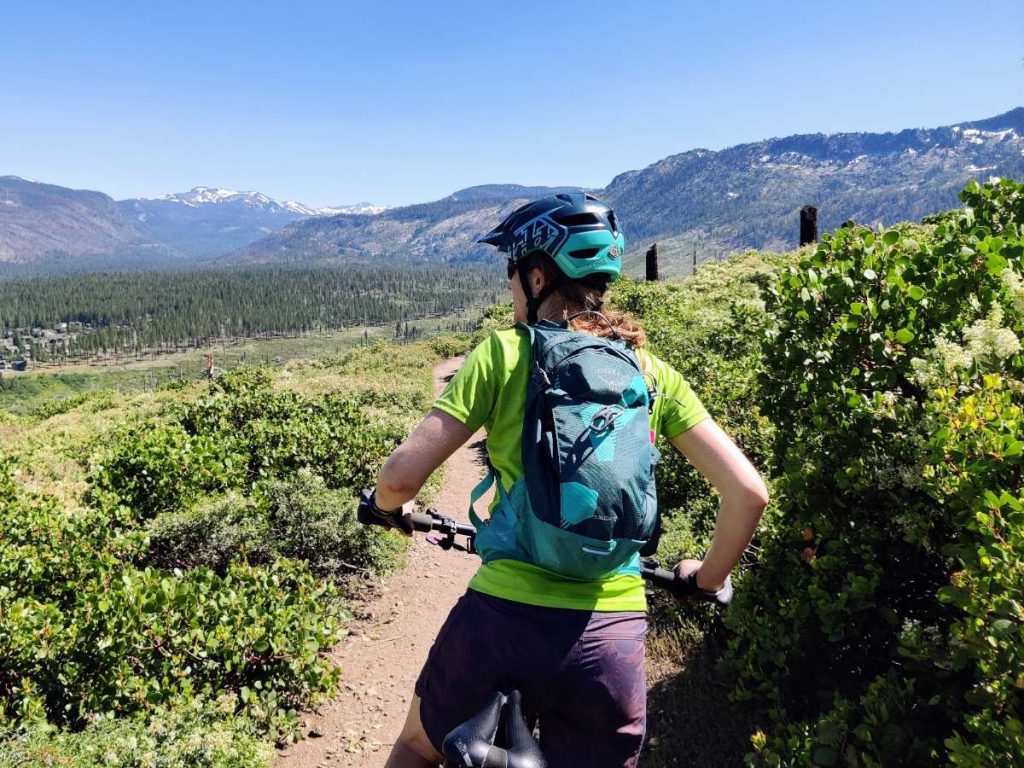
For purposes of this post let’s focus on hydration backpacks, the kind that hold a couple liters of water and between 5 to 15 liters of gear. You can also load up a 40-liter backpack with camping gear if you don’t have all the bikepacking bags, but that’s a different use case with more obvious drawbacks.
What’s great about backpacks:
- Larger gear capacity. Most hip packs carry between 2 – 5 liters of stuff, possibly including water, which is enough for some snacks and small essentials. My 12 liter Osprey hydration backpack can hold much more, like my entire ultralight sleep kit or a couple days of food.
- Larger water capacity. I can carry 3+ liters of water in a backpack if I have to, which would be unwieldy or impossible in any hip pack I’ve seen.
- Water bladder compatibility. Most of us have a backpack hydration bladder sitting around already. Hip pack hydration bladders are a more specialized item with less selection.
- No collision between pack and saddle when standing astride your bike.
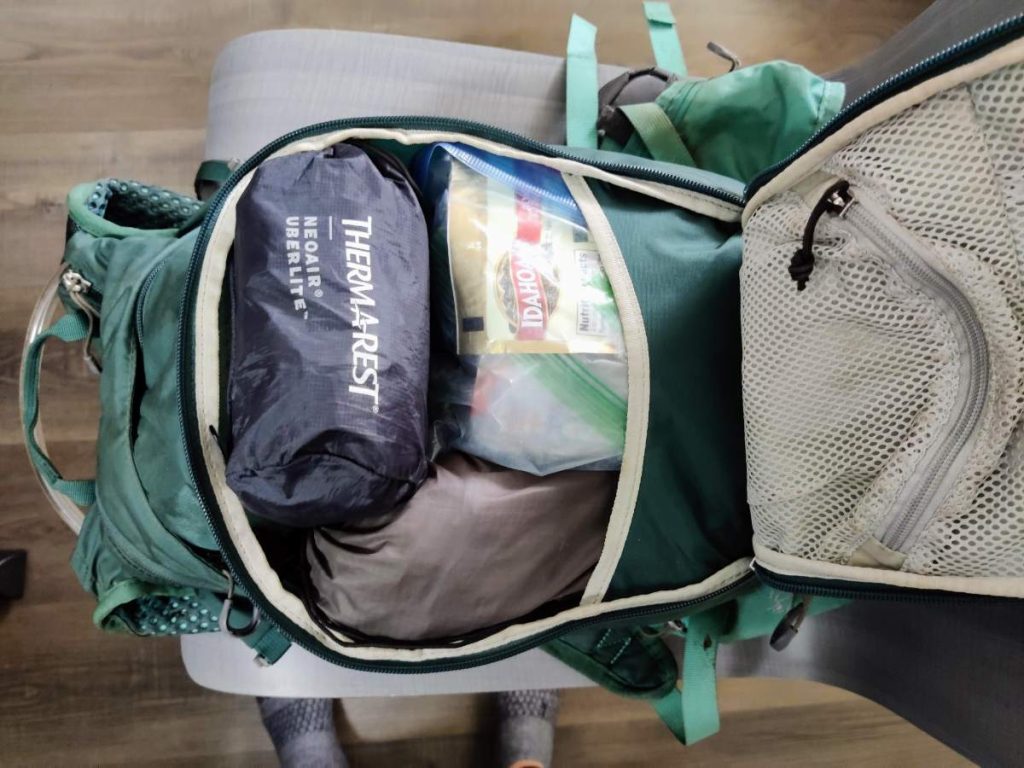
My 12 liter backpack fits a LOT of stuff, like part of my sleep kit and several days of food shown here.
Not so good:
- Hot and sweaty back and shoulders. No matter how fancy the ventilated back panel may be, a backpack accentuates the discomfort of a hot day.
- More fiddly layer changes. I’m very temperature sensitive and sometimes it feels like I’m constantly stopping to add or remove my jacket or vest. I can sometimes slip a loose jacket over a small backpack, but otherwise I have to remove my backpack every time I get too hot or too cold.
- Can’t get inside without taking it off. One unexpected perk of hip packs is the ability to just spin it around and reach inside without undoing the buckle.
- Higher center of gravity. I can’t say this affects my riding performance, which isn’t good enough to be impacted by such a minor factor. But if you love technical riding you might notice it.
- More stuff – more straps, more contact with your body, more adjustments to make. A backpack is just not as minimal as a hip pack.
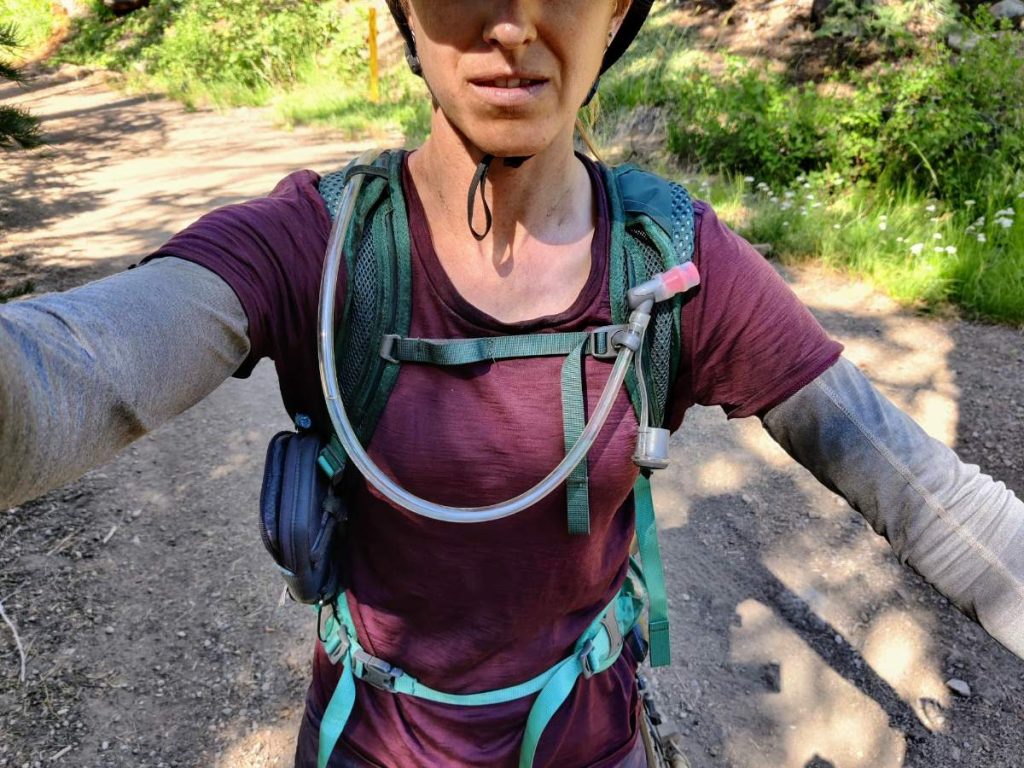
Backpacks are great for carrying more gear, but the amount of body contact and fiddly straps can feel oppressive if you’re sensitive to such things.
When I would choose a backpack over a hip pack:
- When I need more capacity.
- When I need to carry stuff I won’t be using during the day, like camp gear or extra food.
- If I want to save money by using a hydration pack that doubles as hiking or running gear.
Hip Packs
When I first envisioned bikepacking with a hip pack, I imagined the strap pressing painfully into my abdomen and the pack bouncing against my lower back. No thanks!
But when I actually tried riding with one, I realized my mental image had been off. The strap rests lightly across the front of my hip bones and the pack sits securely against my back. I think the forward-leaning posture of cycling works especially well for hip packs because gravity takes some pressure off the front strap.
During my trip with the S/F Expandable Hip Pack I sometimes found myself looking down to make sure I hadn’t left it behind, because I could barely feel it! Can’t say I’ve ever felt that way about a backpack, even my nice Osprey.
While I would never want to do a long bikepacking trip with a backpack, I can actually imagine riding with a hip pack day after day after day.
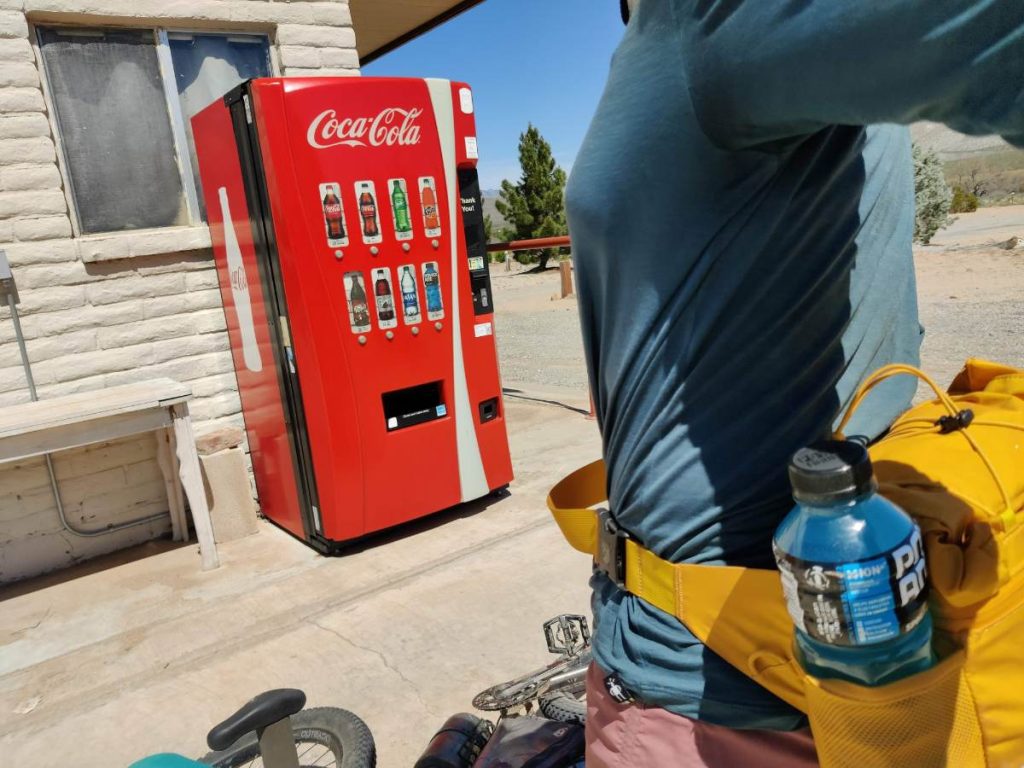
In hot weather I think a hip pack is much more pleasant than a backpack thanks to its smaller area of body contact.
What’s great about hip packs:
- Surprisingly comfortable. While on the bike I could barely feel it.
- Breezy airflow on back and shoulders and much less bag-body contact. On a hot day I prefer the feeling of a hip pack over a backpack, hands down.
- Layer changes don’t require taking it off. Super handy for someone like me who is always too hot or too cold.
- Easier to access without taking it off. During snack breaks I just spun the bag around on my waist and opened the top, no need to unbuckle straps.
- Especially useful for carrying a nice camera. I’ve heard that hip packs are just the right size for a DSLR, and the easy access is perfect for frequent shots.
- Some can double as handlebar bags. This is definitely a niche idea, but a few brands like Dispersed and Swift Industries offer convertible hip packs.
- Handy as a small “purse” when off the bike for resupplies, town stops, and side trips.
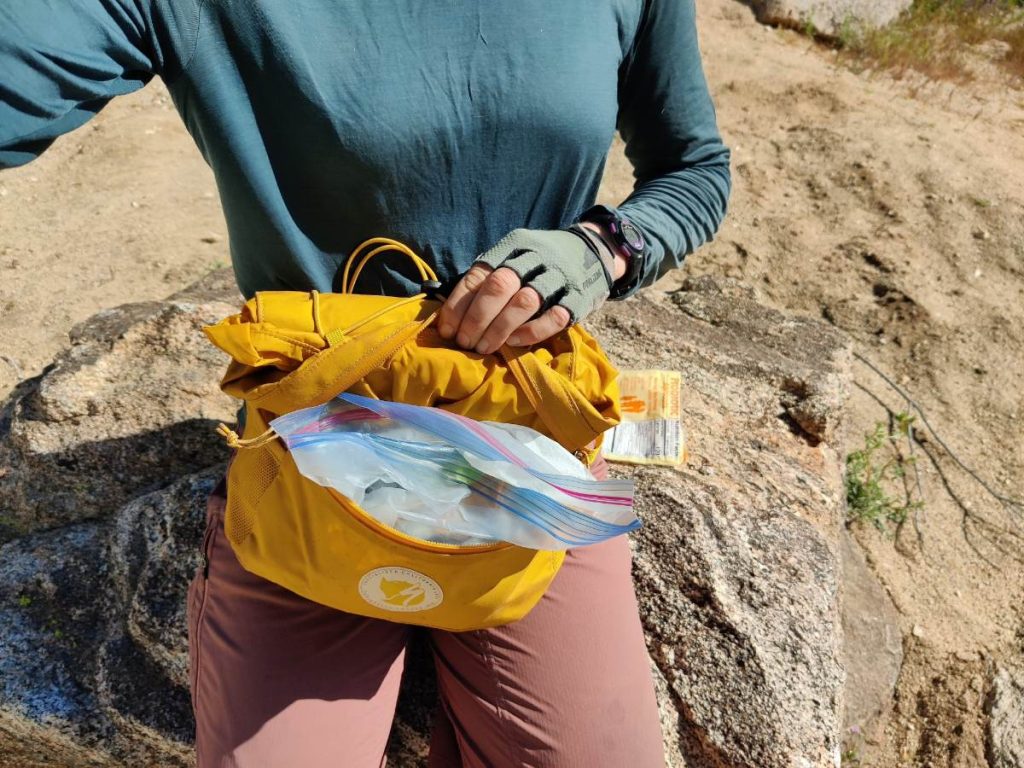
Hip packs are accessible without needing to take them off. Instant snack access!
Not so good:
- Smaller capacity. Hip packs are great for up to about 5 liters of gear or 1 – 2 liters of water. If you need more or want backup capacity for long carries, a hip pack is limiting.
- Limited water options. Some hip packs have bottle holsters on the sides for small small squeeze bottles. Others are are meant to hold a specialized hip pack bladder with capacity usually not more than 1.5 liters.
- Harder to keep hydration hose tucked away, if using a bladder. Maybe I haven’t figured out the trick yet, but with a backpack it’s easy to clip the hose to a shoulder strap.
- Pack can hit saddle during dismount. Though this turned out to be less of an annoyance than I expected, and I learned to adjust my body position to minimize it.
- Potential comfort issues. I was pleasantly surprised by how comfy my hip pack felt, but we’re all built differently.

Hip packs can get in the way when standing astride the bike, but I found this to be less of an annoyance than I expected.
When I would choose a hip pack over a backpack:
- When I only need a little bit of on-body capacity.
- When I mostly want to carry things other than water, especially snacks and small items I’ll be using during the ride.
- When I need extra capacity for a long (say multi-week) bikepacking trip and don’t want to wear a backpack every day, especially in hot weather.
Wrapping Up
In summary, I’ve come to think of a backpack more as a wearable bike bag. I use it to expand my capacity when I need significantly more water or gear space than my bike setup provides, but I’d rather not ride with it day after day if I can avoid it.
A hip pack, on the other hand, strikes me more as a “bikepacking purse,” if you will. It’s more sustainable for a long ride or just more comfy for a short ride. If all you need is a little overflow space and easy-access storage for items you’ll use during the day, a hip pack has a better comfort-to-capacity ratio in my opinion.
More Bikepacking Resources
If you liked this post, you might also like these:
Or visit the bikepacking section for lots more!
About the Author
Hi there, I’m Alissa, founder of Exploring Wild. I’ve traveled over 19,000 miles by bike and still can’t stop planning my next ride (and helping you plan yours). Pavement and panniers or singletrack and seat bag, I love it all. On my bike I feel free. Learn more about me here.
Shop Bikepacking Resources
Bike resources in your inbox?
There’s more where this came from! Sign up here for occasional emails full of inspiration and information about bikepacking and bicycle touring.
The post Is a Backpack or Hip Pack Better for Bikepacking? appeared first on Exploring Wild.
https://exploringwild.com/backpack-or-hip-pack-for-bikepacking/?utm_source=rss&utm_medium=rss&utm_campaign=backpack-or-hip-pack-for-bikepacking
 CampingSurvivalistHuntingFishingExploringHikingPrivacy PolicyTerms And Conditions
CampingSurvivalistHuntingFishingExploringHikingPrivacy PolicyTerms And Conditions
